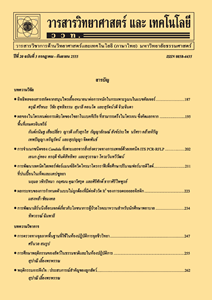การเปรียบเทียบวิธีการประมาณค่าแบบช่วงสำหรับค่าเฉลี่ยประชากรของการแจกแจงแบบเลขชี้กำลัง
Main Article Content
Abstract
บทคัดย่อ
การวิจัยนี้ มีวัตถุประสงค์เพื่อศึกษาและเปรียบเทียบวิธีการประมาณแบบช่วงสำหรับค่าเฉลี่ยประชากร เมื่อตัวแปรสุ่มมีการแจกแจงแบบเลขชี้กำลัง ด้วยวิธี 6 วิธี คือ วิธีวาลด์ วิธีสคอร์ วิธีปรับค่าของวาลด์ วิธีเบส์ วิธีบูตสแตรปสคอร์ และวิธีบูตสแตรปเบส์ โดยเกณฑ์ที่ใช้ในการพิจารณา คือ ค่าความน่าจะเป็นครอบคลุมและค่าเฉลี่ยความกว้างของช่วงความเชื่อมั่น กำหนดขนาดตัวอย่างที่ใช้ในการศึกษาเท่ากับ 5, 10, 25, 50 และ 100 ค่าเฉลี่ยประชากรมีค่าเท่ากับ 1, 5, 10, 20 และ 30 ที่ระดับความเชื่อมั่น 95 % สำหรับวิธีเบส์และวิธีบูตสแตรปเบส์ มีการแจกแจงก่อนแบบแกมมาพารามิเตอร์โดยที่และ ข้อมูลที่ใช้ศึกษาได้จากการสร้างแบบจำลองโดยใช้วิธีการมอนติคาร์โล เพื่อจำลองการทดลองซ้ำ 1,000 ครั้ง ในแต่ละสถานการณ์ของการศึกษา ผลการวิจัยสรุปได้ดังนี้ กรณีตัวอย่างมีขนาดเล็กวิธีที่ให้ค่าความน่าจะเป็นครอบคลุมไม่ต่ำกว่าค่าสัมประสิทธิ์ความเชื่อมั่นที่กำหนดและให้ค่าเฉลี่ยความกว้างของช่วงความเชื่อมั่นแคบที่สุด สามารถพิจารณาได้ดังนี้ เมื่อขนาดตัวอย่างเท่ากับ 5 วิธีที่ได้ คือ วิธีเบส์ ที่มีการแจกแจงก่อนแบบแกมมา (0.5, 3) และวิธีบูตสแตรปเบส์ที่มีการแจกแจงก่อนแบบแกมมา (0.5, 3) และแกมมา (1, 2) เมื่อขนาดตัวอย่างเท่ากับ 10 วิธีที่ได้ คือ วิธีเบส์ที่มีการแจกแจงก่อนแบบแกมมา (0.5, 3) และวิธีบูตสแตรปเบส์ ยกเว้นกรณีที่มีการแจกแจงก่อนแบบแกมมา (0.5, 2) เมื่อขนาดตัวอย่างเท่ากับ 25 วิธีที่ได้ คือ วิธีเบส์ และวิธีบูตสแตรปเบส์ ที่มีการแจกแจงก่อนแบบแกมมา (1, 2) กรณีตัวอย่างมีขนาดใหญ่วิธีการประมาณค่าทุกวิธี ให้ค่าความน่าจะเป็นครอบคลุมไม่ต่ำกว่าค่าสัมประสิทธิ์ความเชื่อมั่นที่กำหนด โดยที่วิธีวาลด์เป็นวิธีที่ให้ค่าเฉลี่ยความกว้างของช่วงความเชื่อมั่นแคบที่สุด ในทุกค่าเฉลี่ยประชากรที่ทำการศึกษา
คำสำคัญ : การแจกแจงแบบเลขชี้กำลัง; ช่วงความเชื่อมั่น; ความน่าจะเป็นครอบคลุม; ค่าเฉลี่ยความกว้างของช่วงความเชื่อมั่น; ค่าเฉลี่ยประชากร; วิธีวาลด์; วิธีสคอร์; วิธีปรับค่าของวาลด์; วิธีเบส์; การสุ่มซ้ำด้วยวิธีบูตสแตรป
Abstract
The objective of this study is to compare six interval estimation methods for the exponential population mean; the methods are Wald method, Score method, Adjusted Wald method, Bayes’ method, Bootstrap Score method and Bootstrap Bayes’ method. The comparison criteria are based on the coverage probability and the average length of the confidence intervals. The study is performed using sample sizes equal to 5, 10, 25, 50 and 100 whereas population means are 1, 5, 10, 20, and 30, 95 % confidence level is used. For Bayes’ method and Bootstrap Bayes’ method using gamma (0.5, 2) gamma (0.5, 3) gamma (1, 1) and gamma (1, 2) as prior distributions. The data are generated through Monte Carlo simulation technique and for each case the simulation is repeated 1,000 times. Results of the research are as follows: For small sample size, the method that has smallest average length confidence interval among the methods that have coverage probabilities not lower than the given confidence coefficient are as follows: when sample size equal to 5, the methods are Bayes’ method using gamma (0.5, 3) as prior distribution and Bootstrap Bayes’ method using gamma(0.5,3) and gamma (1, 2) as prior distributions. When sample size equal to 10, the methods are Bayes’ method using gamma (0.5, 3) as prior distribution and Bootstrap Bayes’ method except when prior distribution is gamma (0.5, 2). When sample size equal to 25, the methods are Bayes’ method and Bootstrap Bayes’ method using gamma (1, 2) as prior distribution. For large sample size, all methods have the coverage probabilities not lower than the given confidence coefficient but Wald method has the smallest average length confidence interval for all population means.
Keywords: exponential distribution; confidence interval; coverage probability; average length; population mean; wald method; score method; adjusted wald method; Bayes’ method, bootstrap resampling


